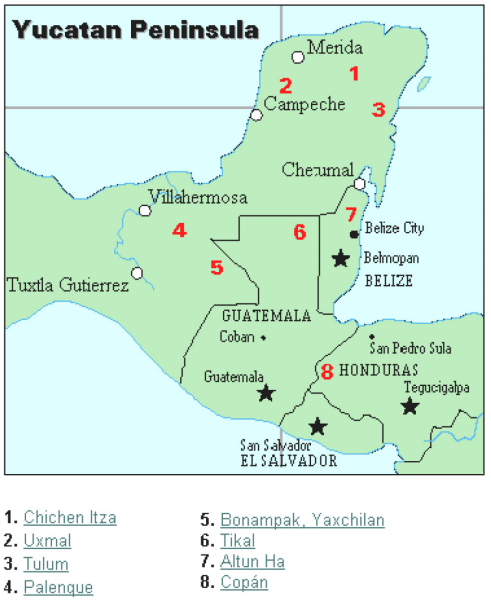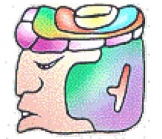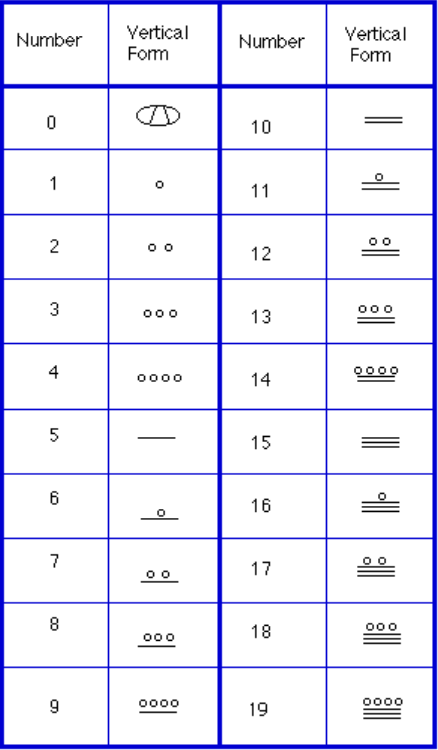Learning Outcomes
- Become familiar with the history of positional number systems
- Identify bases that have been used in number systems historically
- Convert between Base 10 numbers and Mayan numbers
- Add Mayan numbers
Base 10 Positional System
Introduction and Basics
Let’s explore exactly what a base system is and what it means if a system is “positional.” We will do so by first looking at our own familiar, base-ten system and then journey back to Mayan civilization and look at their unique base system, which is based on the number 20 rather than the number 10. Later in this section, we will deepen our exploration by looking at other possible base systems
A base system is a structure within which we count. The easiest way to describe a base system is to think about our own base-ten system. The base-ten system, which we call the “decimal” system, requires a total of ten different symbols/digits to write any number. They are, of course, 0, 1, 2, . . . , 9.
The decimal system is also an example of a positional base system, which simply means that the position of a digit gives its place value. Not all civilizations had a positional system even though they did have a base with which they worked.
In our base-ten system, a number like 5,783,216 has meaning to us because we are familiar with the system and its places. As we know, there are six ones, since there is a 6 in the ones place. Likewise, there are seven “hundred thousands,” since the 7 resides in that place. Each digit has a value that is explicitly determined by its position within the number. We make a distinction between digit, which is just a symbol such as 5, and a number, which is made up of one or more digits. We can take this number and assign each of its digits a value. One way to do this is with a table, which follows:
| 5,000,000 | = 5 × 1,000,000 | = 5 × 106 | Five million |
| +700,000 | = 7 × 100,000 | = 7 × 105 | Seven hundred thousand |
| +80,000 | = 8 × 10,000 | = 8 × 104 | Eighty thousand |
| +3,000 | = 3 × 1000 | = 3 × 103 | Three thousand |
| +200 | = 2 × 100 | = 2 × 102 | Two hundred |
| +10 | = 1 × 10 | = 1 × 101 | Ten |
| +6 | = 6 × 1 | = 6 × 100 | Six |
| 5,783,216 | Five million, seven hundred eighty-three thousand, two hundred sixteen | ||
From the third column in the table we can see that each place is simply a multiple of ten. Of course, this makes sense given that our base is ten. The digits that are multiplying each place simply tell us how many of that place we have. We are restricted to having at most 9 in any one place before we have to “carry” over to the next place. We cannot, for example, have 11 in the hundreds place. Instead, we would carry 1 to the thousands place and retain 1 in the hundreds place. This comes as no surprise to us since we readily see that 11 hundreds is the same as one thousand, one hundred. Carrying is a pretty typical occurrence in a base system.
However, base-ten is not the only option we have. Practically any positive integer greater than or equal to 2 can be used as a base for a number system. Such systems can work just like the decimal system except the number of symbols will be different and each position will depend on the base itself.
Background
As you might imagine, the development of a base system is an important step in making the counting process more efficient. Our own base-ten system probably arose from the fact that we have 10 fingers (including thumbs) on two hands. This is a natural development. However, other civilizations have had a variety of bases other than ten. For example, the Natives of Queensland used a base-two system, counting as follows: “one, two, two and one, two two’s, much.” Some Modern South American Tribes have a base-five system counting in this way: “one, two, three, four, hand, hand and one, hand and two,” and so on. The Babylonians used a base-sixty (sexigesimal) system. In this chapter, we wrap up with a specific example of a civilization that actually used a base system other than 10.
 The Mayan civilization is generally dated from 1500 BCE to 1700 CE. The Yucatan Peninsula (see figure 16[1]) in Mexico was the scene for the development of one of the most advanced civilizations of the ancient world. The Mayans had a sophisticated ritual system that was overseen by a priestly class. This class of priests developed a philosophy with time as divine and eternal.[2] The calendar, and calculations related to it, were thus very important to the ritual life of the priestly class, and hence the Mayan people. In fact, much of what we know about this culture comes from their calendar records and astronomy data. Another important source of information on the Mayans is the writings of Father Diego de Landa, who went to Mexico as a missionary in 1549.
The Mayan civilization is generally dated from 1500 BCE to 1700 CE. The Yucatan Peninsula (see figure 16[1]) in Mexico was the scene for the development of one of the most advanced civilizations of the ancient world. The Mayans had a sophisticated ritual system that was overseen by a priestly class. This class of priests developed a philosophy with time as divine and eternal.[2] The calendar, and calculations related to it, were thus very important to the ritual life of the priestly class, and hence the Mayan people. In fact, much of what we know about this culture comes from their calendar records and astronomy data. Another important source of information on the Mayans is the writings of Father Diego de Landa, who went to Mexico as a missionary in 1549.
 There were two numeral systems developed by the Mayans—one for the common people and one for the priests. Not only did these two systems use different symbols, they also used different base systems. For the priests, the number system was governed by ritual. The days of the year were thought to be gods, so the formal symbols for the days were decorated heads,[3] like the sample to the right[4] Since the basic calendar was based on 360 days, the priestly numeral system used a mixed base system employing multiples of 20 and 360. This makes for a confusing system, the details of which we will skip.
There were two numeral systems developed by the Mayans—one for the common people and one for the priests. Not only did these two systems use different symbols, they also used different base systems. For the priests, the number system was governed by ritual. The days of the year were thought to be gods, so the formal symbols for the days were decorated heads,[3] like the sample to the right[4] Since the basic calendar was based on 360 days, the priestly numeral system used a mixed base system employing multiples of 20 and 360. This makes for a confusing system, the details of which we will skip.
Powers of numbers
Recall that powers of numbers indicate how many times to multiply the base. In the Mayan base 20 number system, the smallest place value is [latex]20^{0} = 1[/latex]. The next is [latex]20^{1}=20[/latex]. The third is [latex]20^{2}=400[/latex], and so on. See the table below for the base-ten values and Mayan names for each of the base 20 number positions.
| Powers | Base-Ten Value | Place Name |
| 207 | 12,800,000,000 | Hablat |
| 206 | 64,000,000 | Alau |
| 205 | 3,200,000 | Kinchil |
| 204 | 160,000 | Cabal |
| 203 | 8,000 | Pic |
| 202 | 400 | Bak |
| 201 | 20 | Kal |
| 200 | 1 | Hun |
The Mayan Number System
Instead, we will focus on the numeration system of the “common” people, which used a more consistent base system. As we stated earlier, the Mayans used a base-20 system, called the “vigesimal” system. Like our system, it is positional, meaning that the position of a numeric symbol indicates its place value. In the following table you can see the place value in its vertical format.[5]

In order to write numbers down, there were only three symbols needed in this system. A horizontal bar represented the quantity 5, a dot represented the quantity 1, and a special symbol (thought to be a shell) represented zero. The Mayan system may have been the first to make use of zero as a placeholder/number. The first 20 numbers are shown in the table above.[6]
Unlike our system, where the ones place starts on the right and then moves to the left, the Mayan systems places the ones on the bottom of a vertical orientation and moves up as the place value increases.
When numbers are written in vertical form, there should never be more than four dots in a single place. When writing Mayan numbers, every group of five dots becomes one bar. Also, there should never be more than three bars in a single place…four bars would be converted to one dot in the next place up. It’s the same as 10 getting converted to a 1 in the next place up when we carry during addition.
In the following video we present more examples of how to write numbers using Mayan numerals as well as converting numerals written in Mayan for into base 10 form.
The next video shows more examples of converting base 10 numbers into Mayan numerals.
Example
What is the value of this number, which is shown in vertical form?
![]()
Example
What is the value of the following Mayan number?

Try It
Convert the Mayan number below to base 10.

Example
Convert the base 10 number 357510 to Mayan numerals.
Writing numbers with bases bigger than 10
When the base of a number is larger than 10, separate each “digit” with a comma to make the separation of digits clear.
For example, in base 20, to write the number corresponding to 17 × 202 + 6 × 201 + 13 × 200, we’d write 17,6,1320.
Try It
Convert the base 10 number 1055310 to Mayan numerals.
Convert the base 10 number 561710 to Mayan numerals.
Adding Mayan Numbers
When adding Mayan numbers together, we’ll adopt a scheme that the Mayans probably did not use but which will make life a little easier for us.
Try It
Try adding 174 and 78 in Mayan by first converting to Mayan numbers and then working entirely within that system. Do not add in base-ten (decimal) until the very end when you check your work.
In the last video we show more examples of adding Mayan numerals.
Candela Citations
- Revision and Adaptation. Provided by: Lumen Learning. License: CC BY: Attribution
- Question ID 6420, 6423. Authored by: Morales,Lawrence. License: CC BY: Attribution. License Terms: IMathAS Community License CC-BY + GPL
- Math in Society. Authored by: Lippman, David. Provided by: http://www.opentextbookstore.com/mathinsociety/. Located at: http://www.opentextbookstore.com/mathinsociety/. License: CC BY: Attribution
- The Mayan Number System: Writing Mayan Number in Base 10. Authored by: James Sousa (Mathispower4u.com) . Located at: https://youtu.be/gPUOrcilVS0. License: CC BY: Attribution
- The Mayan Number System: Writing Mayan Number in Base 10. Located at: https://youtu.be/LrHNXoqQ_lI. License: CC BY: Attribution
- The Mayan Number System: Addition of Mayan Numbers. Authored by: James Sousa (Mathispower4u.com). Located at: https://youtu.be/NpH5oMCrubM. License: CC BY: Attribution
- http://www.gorp.com/gorp/location/latamer/map_maya.htm ↵
- Bidwell, James; Mayan Arithmetic in Mathematics Teacher, Issue 74 (Nov., 1967), p. 762–68. ↵
- http://www.ukans.edu/~lctls/Mayan/numbers.html ↵
- http://www.ukans.edu/~lctls/Mayan/numbers.html ↵
- Bidwell ↵
- http://www.vpds.wsu.edu/fair_95/gym/UM001.html ↵
- http://forum.swarthmore.edu/k12/mayan.math/mayan2.html ↵









